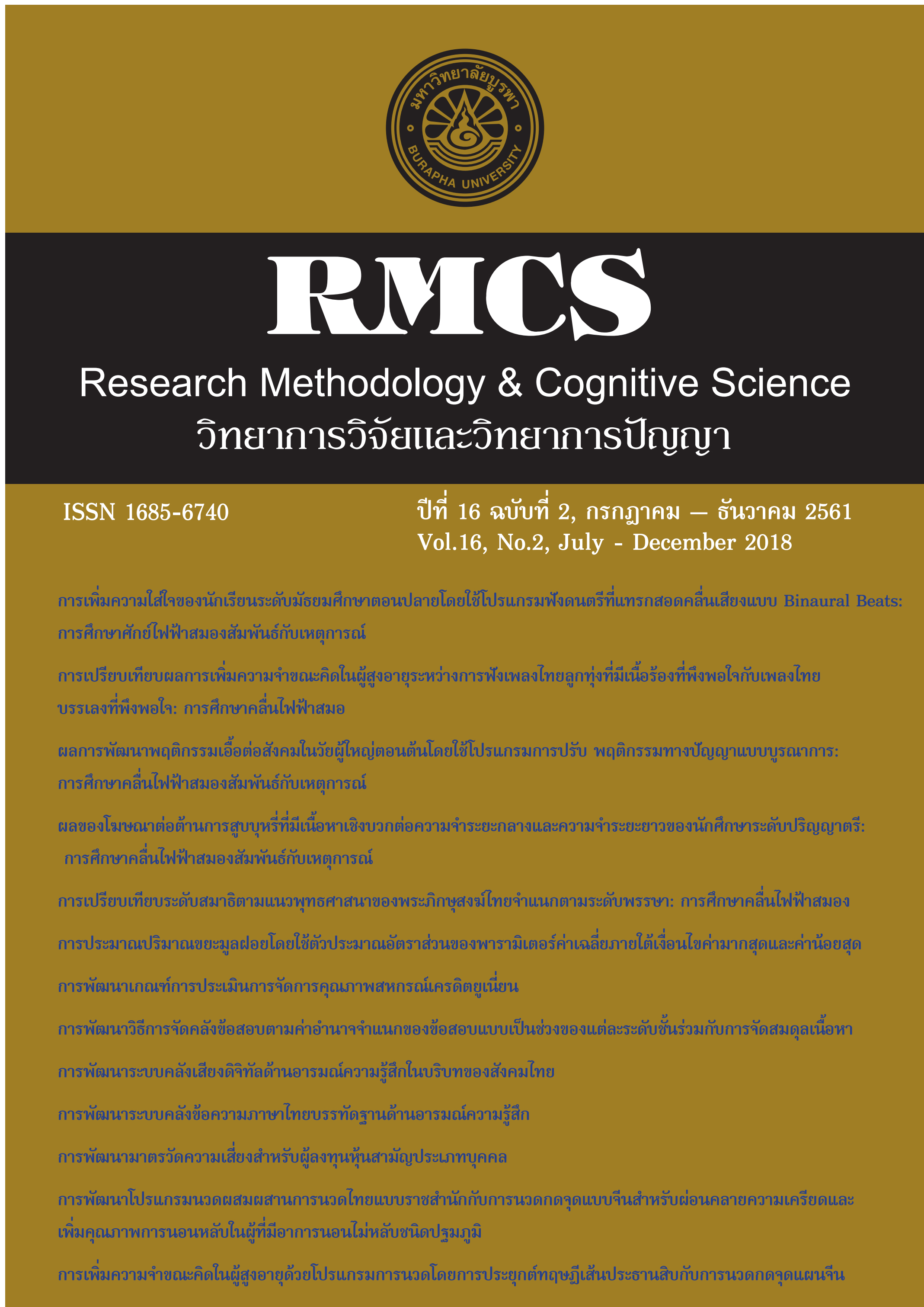Development of a Mixed Massage Program by Integrating the Royal Thai and Chinese Acupressure Techniques for Relieving Stress and Increasing the Sleep Quality of People with Primary Insomnia
Main Article Content
Abstract
Sleep is important for humans. If there is insufficient sleep, it can affect many diseases. The purposes of this research were 1) to develop the massage program mixing the royal Thai massage with Chinese acupressure techniques 2) to study the effects of massage programs by comparing relaxation and sleep quality between the groups receiving the massage with the control group and analyze the relationship between stresses and sleep quality. The sample consisted of 40 volunteers with primary Insomnia aged 15-60 years. They were randomly assigned to the experimental and control group 20 people each. The instruments were the mixed massage program, Sleep measurement, Sleep quality assessment, and Suanprung stress test. Data were analyzed by t-test and correlation coefficient.
The results were as follows. (1) The mixed massage program consists of 11 lines of massage for 55 minutes, 16 points of massage for 15 minutes, and 7 points of Chinese massage for 20 minutes. Total time was 90 minutes. There were three levels of weight: 50, 70, and 90 pounds. (2) After the massage, the comparison within the group found that the stress, the sleep quality, the sleep efficiency, the total sleep time, and the sleep latency of the experimental group were better than before the massage (p <.01). The NREM Stage 3 and REM were not significantly different. (3) After the massage, the comparison between the group found that the stress, the sleep quality, the sleep efficiency and the total sleep time in the experimental group was better than the control group (p <.01). The sleep latency, NREM Stage 3 and REM were not different. (4) Before the massage, the stress was not correlated with sleep quality (r=-.126, p>.05) Due to the sample, stress and sleep quality were similar. But the trend was in the opposite direction that was, if there was less stress, the quality of sleep was better. It was concluded that this mixed massage program can be used to promote sleep quality in people with primary insomnia, to improve sleep quality and to reduce stress.
Article Details
References
จิรภรณ์ แนวบุตร และบุรณี กาญจนถวัลย์. (2561). ผลการนวดไทยต่อระดับความวิตกกังวล ความซึมเศร้าและอาการปวดของผู้ป่วยกลุ่มอาการปวดกล้ามเนื้อ และเยื่อพังผืดที่มารับบริการนวดแผนไทย ณ คลินิกแพทย์แผนไทยประยุกต์ คณะแพทยศาสตร์ มหาวิทยาลัยธรรมศาสตร์. จุฬาลงกรณ์เวชสาร, 60(3), 314-327.
ตะวันชัย จิรประมุขพิทักษ์ และวรัญ ตันชัยสวัสดิ์. (2540). ปัญหาสุขภาพการนอนหลับของพยาบาลประจำการโรงพยาบาลสงขลานครินทร์. วารสารสมาคมจิตแพทย์แห่งประเทศไทย, 45(3), 123-132.
มูลนิธิสาธารณสุขกับการพัฒนา. (2552). ตำราการนวดไทย (พิมพ์ครั้งที่ 4). กรุงเทพฯ: พิมพ์ดี.
วรุตม์ อุ่นจิตสกุล และพิเชษฐ อุดมรัตน์. (2559). ความคิดรู้และพฤติกรรมบำบัดสำหรับภาวะนอนไม่หลับ. วารสารสมาคมจิตแพทย์แห่งประเทศไทย, 61(1), 89-106.
สำนักการแพทย์ทางเลือก. (2556). การแพทย์แผนจีน (Traditional Chinese Medicine). วารสารสำนักการแพทย์ทางเลือก, 6(1), 1-10.
Lobo, A., LóPez-Antón, R., De-La-CÁmara, C., Quintanilla, M. Á., Campayo, A., Saz, P., & Workgroup, Z. A. (2008). Non-cognitive psychopathological symptoms associated with incident mild cognitive impairment and dementia, Alzheimer’s type. Neurotoxicity Research, 14(2-3), 263-272.
Billioti de Gage, S. B., Bégaud, B., Bazin, F., Verdoux, H., Dartigues, J. F., Pérès, K., & Pariente, A. (2012). Benzodiazepine use and risk of dementia: Prospective population based study. Retrived from https://www.bmj.com/content/345/bmj.e6231.short
Chen, J. H., Chao, Y. H., Lu, S. F., Shiung, T. F., & Chao, Y. F. (2012). The effectiveness of valerian acupressure on the sleep of ICU patients: a randomized clinical trial. International journal of Nursing Studies, 49(8), 913-920.
Buttagat, V., Eungpinichpong, W., Chatchawan, U., & Kharmwan, S. (2011). The immediate effects of traditional Thai massage on heart rate variability and stress-related parameters in patients with back pain associated with myofascial trigger points. Journal of Bodywork and Movement Therapies, 15(1), 15-23.
Dreyer, N. E., Cutshall, S. M., Huebner, M., Foss, D. M., Lovely, J. K., Bauer, B. A., & Cima, R. R. (2015). Effect of massage therapy on pain, anxiety, relaxation, and tension after colorectal surgery: A randomized study. Complementary Therapies in Clinical Practice, 21(3), 154-159.
Edmonds, W. A., & Kennedy, T. D. (2017). An applied guide to research designs: Quantitative, qualitative, and mixed methods. Los Angeles: Sage Publications.
Han, L., Li, J. P., Sit, J. W., Chung, L., Jiao, Z. Y., & Ma, W. G. (2010). Effects of music intervention on physiological stress response and anxiety level of mechanically ventilated patients in China: a randomised controlled trial. Journal of Clinical Nursing, 19 (7-8), 978-987.
Hershner, S. D., & Chervin, R. D. (2014). Causes and consequences of sleepiness among college students. Nature and science of sleep, 6(1), 73.
Jones, J., Thomson, P., Lauder, W., Howie, K., & Leslie, S. J. (2012). Reflexology has an acute (immediate) haemodynamic effect in healthy volunteers: A double-blind randomised controlled trial. Complementary Therapies in Clinical Practice, 18(4), 204-211.
Leger, D., & Bayon, V. (2010). Societal costs of insomnia. Sleep Medicine Reviews, 14(6), 379-389.
Lobo, A., LóPez-Antón, R., De-La-CÁmara, C., Quintanilla, M. Á., Campayo, A., Saz, P., & Workgroup, Z. A. R. A. D. E. M. P. (2008). Non-cognitive psychopathological symptoms associated with incident mild cognitive impairment and dementia, Alzheimer’s type. Neurotoxicity Research, 14(2-3), 263-272.
Mandıroglu, S., & Ozdilekcan, C. (2017). Impact of acupuncture on chronic insomnia: A report of two cases with polysomnographic evaluation. Journal of acupuncture and meridian studies, 10(2), 135-138.
Moraska, A., & Chandler, C. (2009). Changes in psychological parameters in patients with tension-type headache following massage therapy: a pilot study. Journal of Manual & Manipulative Therapy, 17(2), 86-94.
Nerbass, F. B., Feltrim, M. I. Z., Souza, S. A. D., Ykeda, D. S., & Lorenzi-Filho, G. (2010). Effects of massage therapy on sleep quality after coronary artery bypass graft surgery. Clinics, 65(11), 1105-1110.
Wright, S., Courtney, U., Donnelly, C., Kenney, T., & Lavin, C. (2002). Clients’ perceptions of the benefits of reflexology on their quality of life. Complementary Therapies in Nursing and Midwifery, 8(2), 69-76.
Yin, X., Gou, M., Xu, J., Dong, B., Yin, P., Masquelin, F., & Xu, S. (2017). Efficacy and safety of acupuncture treatment on primary insomnia: a randomized controlled trial. Sleep Medicine, 37(1), 193-200.

